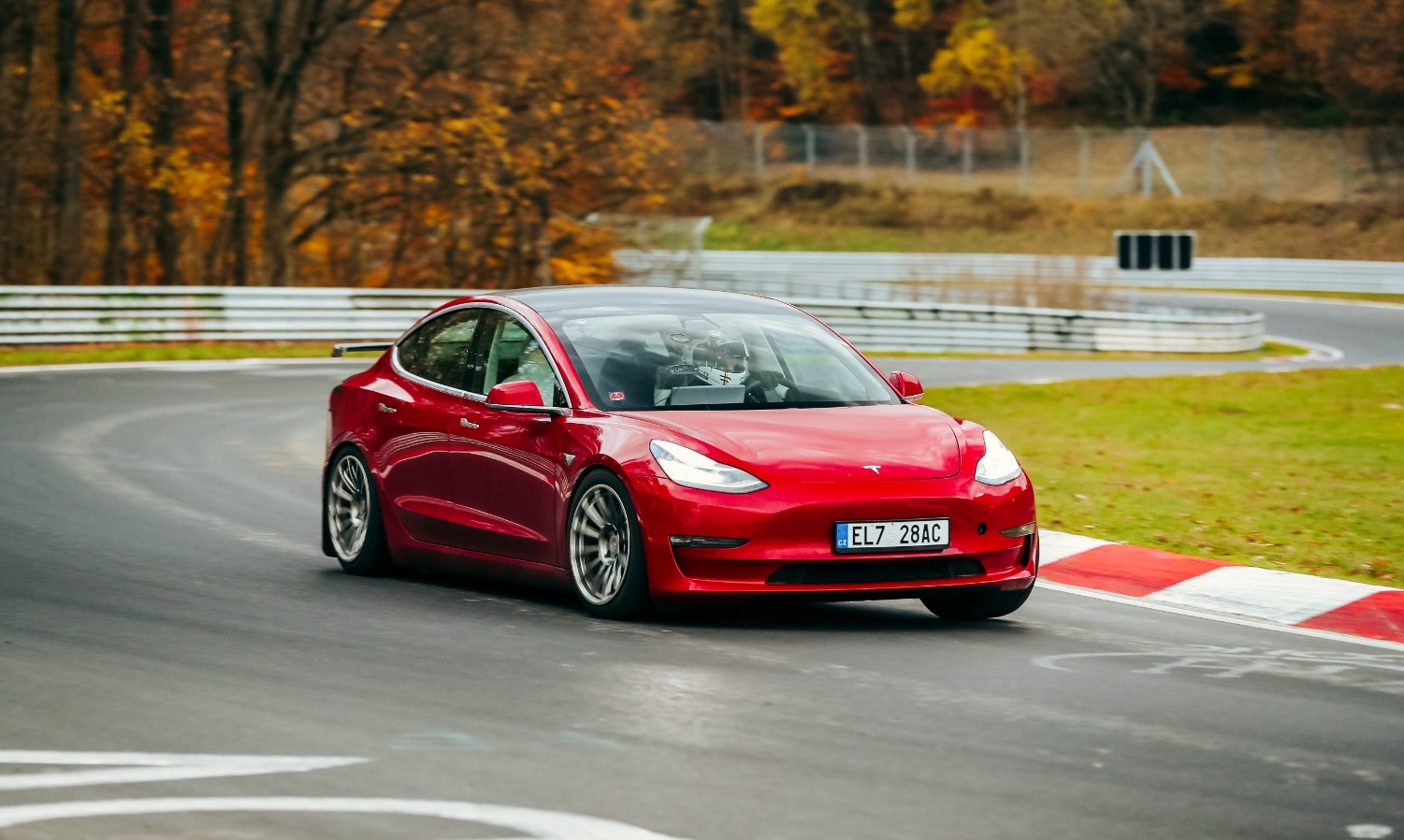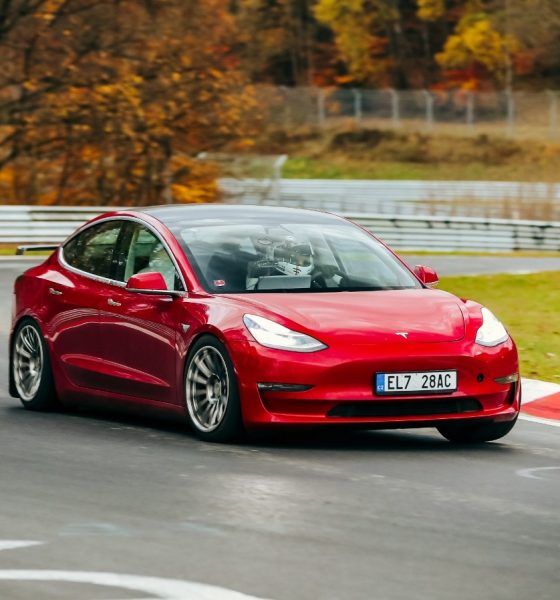

News
Tesla Model 3 takes on the Nurburgring, approaches Porsche Taycan-level lap time
Back in August 2019, Porsche made headlines when it revealed that its all-electric Taycan Turbo had been able to complete a lap around the Nürburgring in 7 minutes 42 seconds, well below the company’s target time of sub-8 minutes. The feat was celebrated by the EV community, and even Tesla CEO Elon Musk, who poked fun at the vehicle’s “Turbo” moniker, stated that the Taycan “does seem like a good car.” Musk added that the Taycan Turbo’s “Nürburgring track time is great.”
The Porsche Taycan Turbo’s 7:42 lap around the Nürburgring was widely celebrated because very few production electric cars are capable of performing at optimum around the unforgiving nearly-13-mile track. The Nürburgring is dubbed the “Green Hell” for a reason, and one of these is that it is a track that has the potential to take its toll on both drivers and cars alike. It was then cause for celebration when Porsche, with its decades of racing experience, finally proved that even production EVs could run an impressive lap around the Nürburgring.
What is rather remarkable is that a Tesla Model 3 Performance, a vehicle that quite literally costs a fraction of the Taycan Turbo, seems to be on track to close in on the Taycan Turbo’s lap. During a run around the Nürburgring with traffic and on wet pavement, the Tesla Model 3 Performance was able to complete a lap (bridge-to-gantry) around the Nürburgring in 7:44. This was made possible by rather simple upgrades to the vehicle, such as better suspension and brakes.
Quite interestingly, the Model 3 Performance that ran a 7:44 in the Nürburgring was the same vehicle that made the rounds in the EV community back in September. Back then, the vehicle, which was partially modified, was driven around the Nürburgring by YouTube auto reviewer Misha Charoudin. That run, which became quite meme-worthy due to the reactions of the vehicle’s passenger, was completed in 8 minutes 10 seconds.
The vehicle has since been undergoing more improvements from Tesla tuning house Unplugged Performance. As noted by Unplugged CEO Ben Schaffer, the Model 3 Performance had received some upgrades to its suspension, brakes, and wheels. And with these modifications, the Model 3 Performance took to the track once more with driver Luis Ramirez behind the wheel. The result was the all-electric sedan’s 7:44 lap with traffic and on wet pavement.
In a statement to Teslarati, Schaffer remarked that the Model 3 could probably beat the Taycan Turbo’s lap time with a street tune. At its full potential, the Unplugged CEO estimates that the Model 3 Performance may actually be capable of running a lap around the Green Hell in the 7:30 range. If that were to pass, it would most definitely be more difficult to dismiss the capabilities of electric vehicles in a racetrack. The Model 3, after all, is a reasonably-priced electric car, and even with its modifications included, very few vehicles in its price range could accomplish a 7:44 lap around the Nürburgring in similar conditions.
Here’s the Model 3 Performance’s previous 8:10 lap around the Green Hell.

Elon Musk
Elon Musk just said some crazy stuff about the Tesla Roadster

Elon Musk appeared on the Moonshots podcast with Peter Diamandis today to discuss AGI, U.S. vs. China, Tesla, and some other interesting topics, but there was some discussion about the upcoming unveiling of the Roadster, the company’s electric supercar that will arrive several years after it was initially slated for release.
Musk made some pretty amazing claims about the Roadster; we already know it is supposed to be lightning-fast and could even hover, if Tesla gets everything to happen the way it wants to. However, the car has some pretty crazy capabilities, some of which have not even been revealed.
On the podcast, Musk said:
“This is not a…safety is not the main goal. If you buy a Ferrari, safety is not the number one goal. I say, if safety is your number one goal, do not buy the Roadster…We’ll aspire not to kill anyone in this car. It’ll be the best of the last of the human-driven cars. The best of the last.”
🚨 Elon on the Roadster unveiling, scheduled for April 1:
— TESLARATI (@Teslarati) January 6, 2026
Musk makes a good point: people who buy expensive sports cars with ridiculous top speeds and acceleration rates do not buy them to be safe. They hope they are safe in case of an emergency or crash, but safety is not at the forefront of their thoughts, because nobody buys a car thinking they’ll crash it.
The Roadster is truly going to push the limits and capabilities of passenger vehicles; there’s no doubt about that. Tesla plans to show off the new version car for the first time on April 1, and Musk has only hinted at what is possible with it.
Musk said back in November:
“Whether it’s good or bad, it will be unforgettable. My friend Peter Thiel once reflected that the future was supposed to have flying cars, but we don’t have flying cars. I think if Peter wants a flying car, he should be able to buy one…I think it has a shot at being the most memorable product unveiling ever. [It will be unveiled] hopefully before the end of the year. You know, we need to make sure that it works. This is some crazy technology in this car. Let’s just put it this way: if you took all the James Bond cars and combined them, it’s crazier than that.”
Production is set to begin between 12 and 18 months after the unveiling, which would put the car out sometime in 2027. Hopefully, Tesla is able to stay on track with the scheduling of the Roadster; many people have been waiting a long time for it.
News
Tesla launches hiring for Robotaxi program in its twentieth country
Overall, the hiring signals Tesla’s aggressive timeline for global dominance in autonomous mobility.

Tesla has launched a hiring initiative for its Robotaxi program in its twentieth country, as the company posted two new jobs in Thailand this week.
Tesla is hiring in Bangkok and Kowloon for the Vehicle Operator position, which is related to data collection, and is the first in Thailand, but the twentieth country overall, as the company tries to expand into other markets.
🚨 BREAKING: Tesla is hiring additional full-time Vehicle Operators in Bangkok, Thailand.
Previous openings were 6-month, part-time roles. These are equivalent to AI Safety Operator roles in the U.S. pic.twitter.com/R6LzoU1bos— Tesla Yoda (@teslayoda) January 5, 2026
Tesla has had active job postings for Vehicle Operator positions in the United States, India, Israel, Taiwan, Germany, the Czech Republic, Hungary, the UK, Finland, Switzerland, Sweden, the Netherlands, Austria, Spain, Norway, Italy, and Turkey in past listings.
These postings are not all currently available, likely because the roles have been filled.
Thailand is the most recent, and broadens the company’s potential path to expanding its ride-hailing program, which is only active in the United States in Austin, Texas, and the California Bay Area, so far.
These roles typically involve data collection, which assists in improving Autopilot and Full Self-Driving operation. Tesla’s self-driving programs utilize real-world data that is accumulated and stored, observing vehicle and traffic behavior, as well as tendencies that are performed by human drivers to help increase safety and overall performance.
Overall, the hiring signals Tesla’s aggressive timeline for global dominance in autonomous mobility. Although the company has several high-profile rivals and competitors in the field, it has established itself as a main player and a leader in the development of autonomous technology, especially in the U.S., as its FSD suite is refined on almost a weekly basis.
The Full Self-Driving suite is available in seven countries and territories currently, including the U.S., Canada, China, Mexico, Puerto Rico, Australia, and New Zealand. Its biggest goal for expansion is currently the European market, where regulatory hurdles have been the main bottleneck prolonging its launch on the continent.
Tesla has performed months of testing in various European countries, including France and Spain, and does have support in some areas from various regulatory agencies. However, the company is hoping to get through this red tape and offer its suite in Europe for the first time, hopefully this year.
News
Tesla China rolls out Model Y upgrades, launches low-interest financing
These strategies are aimed at improving the ownership experience and keeping vehicle pricing competitive in the world’s largest electric vehicle market.

Tesla has rolled out minor updates to the five-seat Model Y in China, upgrading the vehicle’s center display to a higher-resolution 16-inch 2K screen. The electric vehicle maker also introduced attractive financing options, including 7-year low-interest rates, to offset the new purchase tax on EVs.
These strategies are aimed at improving the ownership experience and keeping vehicle pricing competitive in the world’s largest electric vehicle market.
Five-seat Model Y gets larger, better display
With its recent update, all three variants of the five-seat Model Y now feature an upgraded 16-inch 2K resolution center display, which replaces the vehicle’s previous 15.4-inch 1080p panel. This screen was already used in the six-seat Model Y L, and it offered improved visual clarity. Tesla China has also updated the Model Y’s headliner to black, giving the vehicle a sleeker appearance.
Prices of the five-seat Model Y remain unchanged at RMB 263,500, RMB 288,500, and RMB 313,500 for the respective trims. This update enhances the cabin experience as domestic rivals are already adopting high-resolution screens. As noted in a CNEV Post report, some domestic automakers have begun rolling out vehicles equipped with 3K-resolution displays.
New financing offers
Tesla also launched ultra-long-term financing offers for its locally produced models in China, which include the Model 3 sedan, the five-seat Model Y, and the six-seat Model Y L, through January 31, 2026. The 7-year option features an annualized fee rate as low as 0.5%, which is equivalent to 0.98% interest. This is expected to save customers up to RMB 33,479 ($4,790) compared to standard rates.
A 5-year zero-interest plan is also available, and it has been extended to the Tesla Model Y L for the first time. These incentives help offset China’s new 5% purchase tax on New Energy Vehicles (NEVs) in 2026-2027. Some of Tesla’s rivals in China have announced in recent months that they would be covering the purchase tax owed by buyers early this year.








